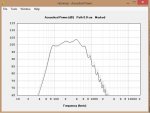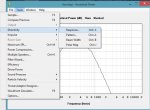That's a great idea

~

~:smile: Thanks!
You bet, and thx to you guys !
Ok, just to try to help move towards some "universal" 60 degree plans....
In my mind, the majority of thinking comes down to choices for width, depth, 12" baffles, HF horn baffle, and back corners. And of course plywood thickness. Height seems to be the one thing that pretty much stays fixed....:?~:-?~:???:
* Ply Thickness........ my vote would be for plans drawn up for 15mm....seems like a good middle of road, and it is available in baltic birch
* Width....seems like choices are either ..
1. hold the exterior at, or slightly wider, than the XT1464 ...so 380mm + 0-6mm, or
2. hold interior width to fit the 380mm horn + a couple mm for wiggle room. Net decision: say 386mm vs 412mm (w 15mm ply)
I'm leaning towards the wider version for ease of construction and opportunity for one piece HF horn baffle.
I figure the wider version adds about 2 lbs....
* Depth....my vote here is the way Peter did his ...455 deep, with front set back of 30mm for HF horn baffle. But this vote is assuming this extra depth (455mm) vs the 90 degree version (430mm) helps the MF horn response? If not, why have it?
But if we do go with 455mm, i'm under the impression the cabinet shouldn't extend past the HF horn mouth due to diffraction,… and that's why Peter has it stepped...correct?
And if we go this way, we need new MF horn piece dimensions...yes?
I figure the extra depth adds maybe another pound and a piece..
* 12" baffles. Right now, I'm thinking 15mm ply routed out 6mm, with a 6mm spacer ring, for a 12mm xmax clearance. This is the lightest strongest alternative I have been able to picture.
Question for you guys....what do you think strengthwise, of your baffles after routing? What's the minimum thickness you would leave at the deepest route?
* HF horn baffle..... I've already voted for the extra width to get it inside and make it one piece.
I also like the idea of a non-beveled baffle, on the top and bottom edges, where it joins the MF horn flares. It was very easy to make a baffle with square edges that mated to the bevel on the MF horn flares that was simply rotated 90 degrees, to make the bevel be perpendicular to the front of the speaker.
* Corners....make the box square for simplicity and let any brave souls lop off corners like Peter did !
Not so ‘universal’ thoughts….. Also, REALLy thinking to make at least the back, top, and bottom out of 12mm BB... (if not the sides too.. It wouldn't be too hard to put a couple of side to side braces in .)
That could get her down below 70lbs.
But I would suggest keeping the 'universal’ plans at some constant ply thickness and let us tinker at our own peril

~:-o~

Hope these beginning suggestions help get a dialog going ....





